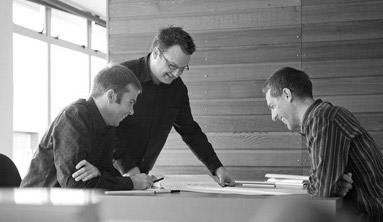User stories is a regular column here on the WorkflowMax blog. Here, we get a company to walk us through their workflow process. Every company is different, and every firm has different methods and processes for managing their projects. Our hope is that by studying what others do, youcan find techniques to improve your own workflow.
Today we talk to Cymon Allfrey (Architect, Founder) and Clive Weston (Practice Manager) from Cymon Allfrey Architects, a Christchurch-based architectural firm who specialise in all aspects of design, from residential and commercial buildings, to apartment complexes, retail spaces and earthquake remediation. The practice has achieved recognition for many of its projects, three highlights of which were being awarded the Supreme National Design Award for Architectural Designers New Zealand (ADNZ) in 2007, 2010 and 2011 – distinctions that recognise and reiterate the impeccable standard of the company’s work.
About The Company: Cymon Allfrey Architects

Cymon: I brought into a practice in 2000. That company had been going strong for 40 years, and I became a director. I stayed there for ten years, then decided I wanted to step out on my own. So I started Cymon Alfrey Architects. We’ve been in business now for four years, and we have 11 employees and 5 contractors.
We’ve set ourselves up as more of a boutique practice. So we do fewer jobs, but the jobs we do are of exceptional quality. We work with the client from the very first stages of developing concepts, right through to completion of projects. We have a very commercial approach to the way we design and build our work.
What types of projects have you been working on?

Cymon: We like to work with end user of the building. We like to work with people who have both literal and figurative buy into the end result. Good architecture can only be “tested” in its final form and from my part, while I want to see a beautiful building, I also want to make sure that they are equally functional. A building should meet people’s needs. And people who are passing on the street can appreciate the building while they are there … or perhaps they don’t -- at least they have an opinion.
We do a lot of higher-end residential, multi-unit dwellings, and commercial buildings (both industrial and office spaces). If you ask an architect what he’s working on, he’s going to want to show you pictures, so check out some of the projects on our website to get an idea of what we do.
What tools do you use to manage your architecture firm?

Clive: There are a lot of balls in the air to keep the practise going. So many jobs to manage -- lots of costs coming in, lots of invoices getting paid. And when I started, I was looking to use Excel for all this. Excel for time sheeting, Excel for quoting on the job, Excel for starting the job,
For a small company with 5-6 people, there was a lot of compliance, a lot of structure and a lot of boxes to tick. A lot of time was spent on ticking the boxes, opening and fiddling with the spreadsheets, rather than actually getting the work done. Angela spent 2-3 hours every day sorting out timesheets. So Excel was out.
I figured there must be a better way to do all this. So we found Xero and WorkflowMax. Under the new workflow, the staff time is going directly from bum-on-a-seat straight into the system. On invoicing day I just go into WorkflowMax and print out a work-in-progress report and run a highlighter through it (I did this under the old system, but it would take a century, now it just takes me 15 minutes), and I just do a bulk progress invoice. I do all this myself, because I need to approve them all anyway. A third of them are projects led by other people on the team, so I will just print those in bulk and give it to the appropriate project manager, go through any under-recoveries or over-recoveries adjusted in WorkflowMax, export into Xero and change the description. I submit it for approval and then Angela goes through and makes sure I don’t have typos or anything.
We just do invoicing on the first working day of the month. the first working day of every month is blocked out in my diary for invoicing. All of our agreements we bill on monthly basis.
What are your main challenges when it comes to workflow?
Clive: One of the weakness of our current workflow is that we haven’t trained our senior guys to produce their own invoices. I will go into WorkflowMax, and adjust the invoice to the nearest rounding -- so putting a layer of over- or under-recovery on, and then export into Xero.
We have 3 other people in the team who are responsible for invoicing -- so I print their invoices and then give it to them and then they will hand write on it and then I go and enter that in WorkflowMax - so we haven’t taught them how to do this in WorkflowMax themselves yet.
Cymon: Also, we set the project fee before we determine the time. Half of our work is based on hourly basis. So there is no quote. It is what is. The other half are fixed price quotes. So we do track time/costs internally even for those fixed price jobs, but not through WorkflowMax.
Lets say we have a job of $50K. First thing what I will do set a recovery target. The Recovery target means ‘given the risks around the project, type of project, etc. we want to target completing this job for $40K, and the balance is basically “over recovery” or buffer.’ If we don’t do this, then we will be under-recovery a lot of time as it will probably cost us $55K. So we set ourselves a recovery target.
How Do You Hope to Improve Your Workflow?
Cymon: Each project has a manager, and they will manage the entire cost and completion of the project. We don’t do that in WorkflowMax right now, and it’s probably because we don’t think it should be managed at the practice management level. It’s probably a too fine a level of detail to work on at the practice management level.
What’s happened over time is that we have developed this process of costing sitting outside Workflowmax. We may have to look into taking into the next level and see what if we put it inside WorkflowMax. There is no reason why we can’t put our individual hour estimates during the detail design phase and monitor against it. There is no reason why we couldn’t do that.
What do you Love Most About WorkflowMax?
Cymon: There’s a seamless transition from a bum-on-a-seat to an invoice. That for me has been the major one. Being able to just simplify that process.
I love the data that you can extract from it can help you understand the performance on a project. Example -- If I’m pricing a job, the back-costing of a previous job helps inform the costing of the new job. I can extract that information within a matter of seconds, and it’s very easily accessible.
And, of course, being able to use the software anywhere. The fact that we have 5 contract staff that are out of the office, and they can input their time into our system, and understand in real-time what’s going on.
If I’m sitting at home and I’m working on a project or report, I can go straight into the system to see what’s been done and what hasn’t been done. So being able to access all this data and manage the business - anytime, anywhere - is extremely valuable.
In 2012, I did my invoicing from the Hong Kong airport. It was the first working day of the month -- which is always booked out in my diary to do invoicing. I just sat there and completed the entire invoicing for the month from the airport. It was productivity at its best. I was even able to send them all to Xero where they were saved as a draft. That was amazing - the power of the cloud. That was fantastic really!
Cymon and Clive also recently came to Auckland and did a presentation on how they manage their workflow. You can check out the video below:
Thanks Cymon and Clive! If you're running a company using WorkflowMax and want to talk workflow with us, then drop us a line at steff.green@xero.com and we can interview you for User Stories.






